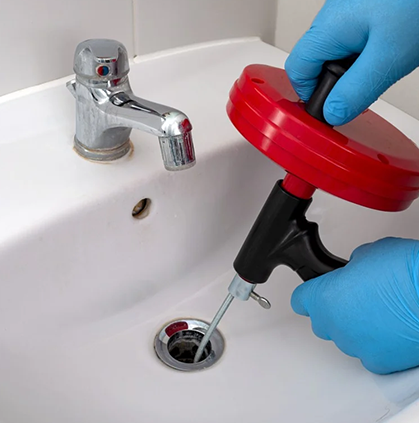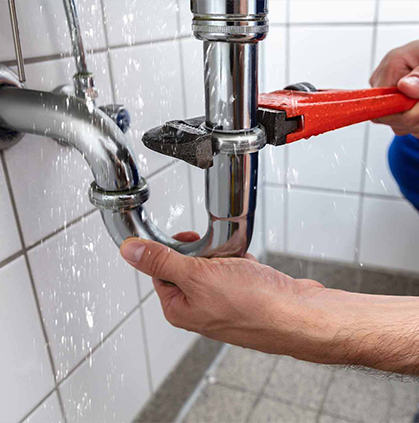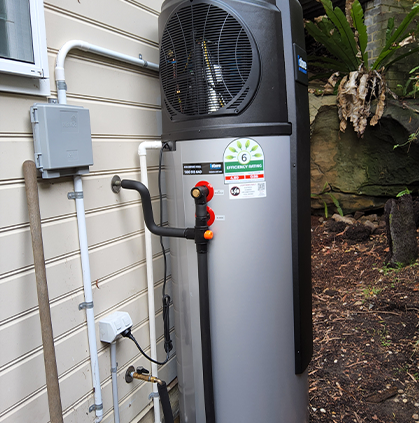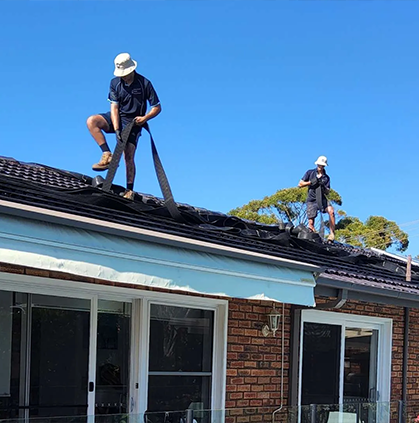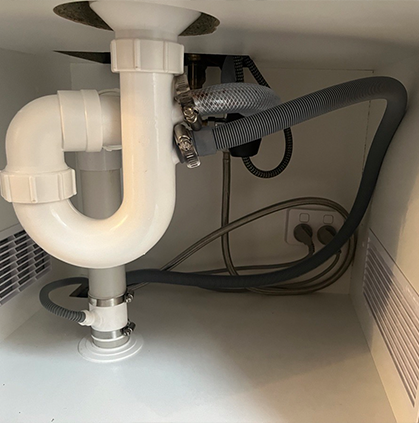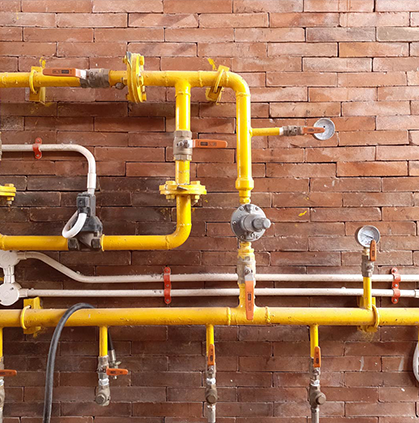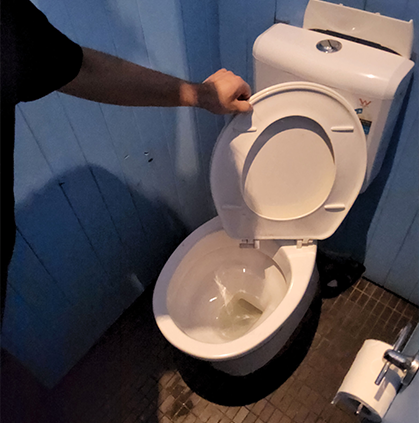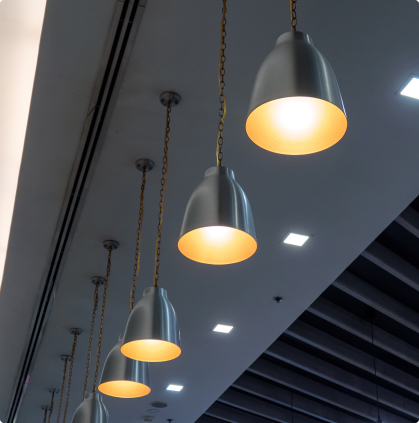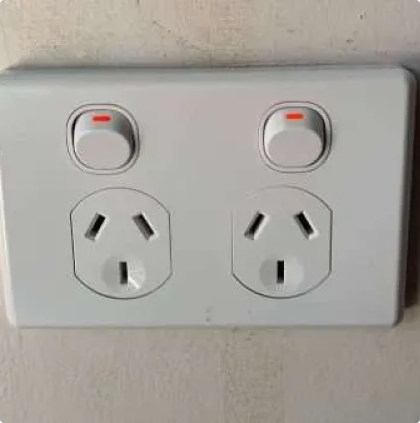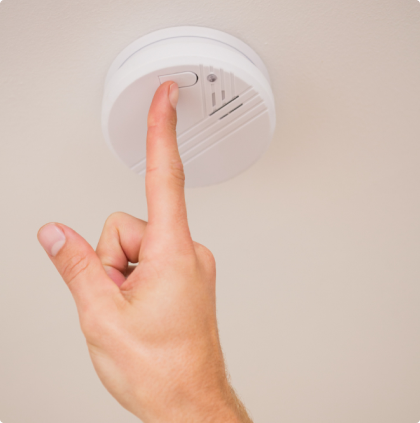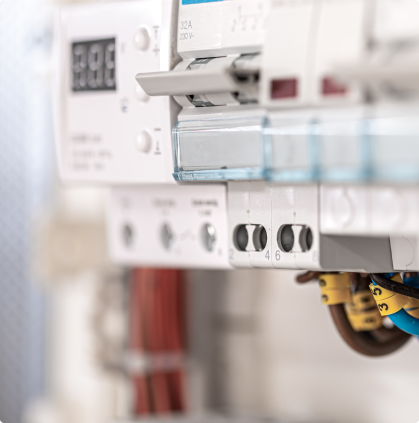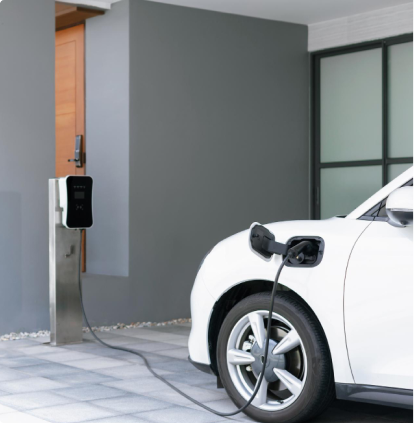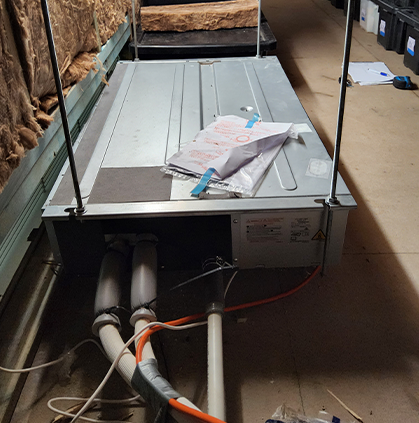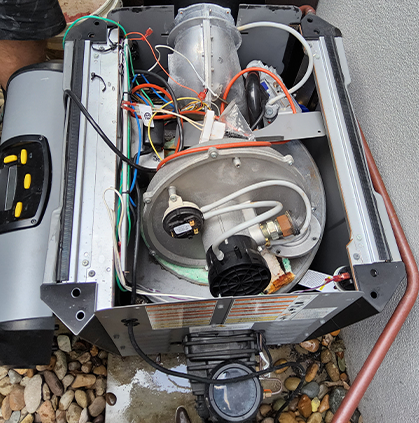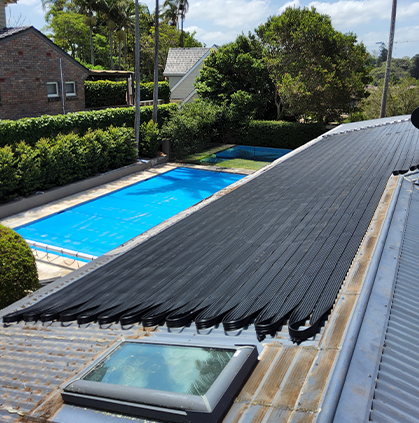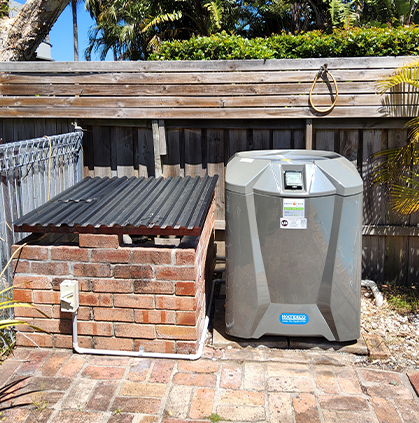Do you have an air handler unit and want to know what it does? Or are you about to install a new HVAC system and wondering if you need an air handler?
Don’t worry. This guide explains the components inside that metal box and the types of air handlers. You’ll learn when you need one, how to maintain it, and what to ask for during air conditioning services appointments.
What is an Air Handler?
Your air handler is a metal box containing a blower and an evaporator coil. It’s the indoor part of your split HVAC system.
You’ll see it like a tall, skinny fridge made of galvanised steel, usually 120-135 cm high and only 45-55 cm wide. And you’ll find it in neutral colours like grey or beige, and it weighs 35 to 70 kg.
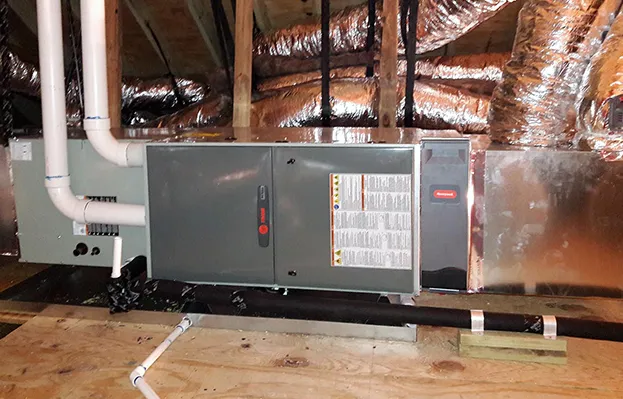
Your air handler unit looks a bit like a furnace, but you won’t find any gas lines, burners, or exhaust flue pipes on it. It’s usually installed out of sight in your roof space, garage, or a utility cupboard.
Role of Air Handler in an HVAC System
Your air handler is responsible for moving air around your home. It doesn’t heat or cool the air itself. And this is a common point of confusion about how AC system works.
The cooling in your home relies on your indoor and outdoor units working together. Your outdoor unit compresses the refrigerant, while the actual heat exchange with your room’s air happens at the indoor coil.
Here’s how it works: the blower pulls your room’s air through a filter, cleaning it before moving it across the indoor coil.
There, the refrigerant absorbs the heat, cooling the air. As this happens, moisture condenses on the coil and drains away, reducing the humidity.
The conditioned air then flows through your ducts while heated refrigerant returns outside to release heat.
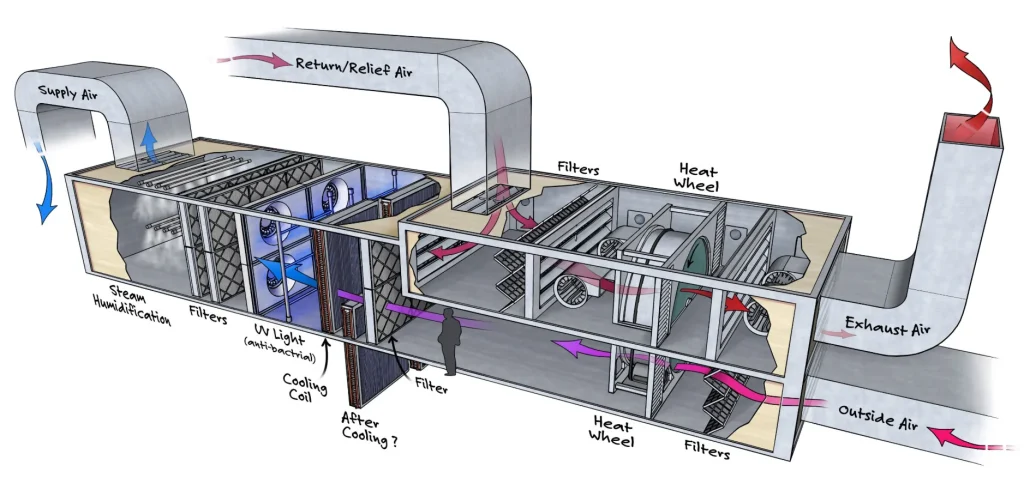
So, your air handler is responsible for three jobs:
- filtering incoming air
- cooling and controlling humidity at the coil
- circulating the conditioned air
All three roles work together as part of your split systems installation.
Types of Air Handler
Here are seven types of air handlers you might want to consider for your home:
1. Single-Speed Air Handlers
This is one of the simplest types of air handlers available. Its motor is either on at full speed or completely off, with no settings to adjust.
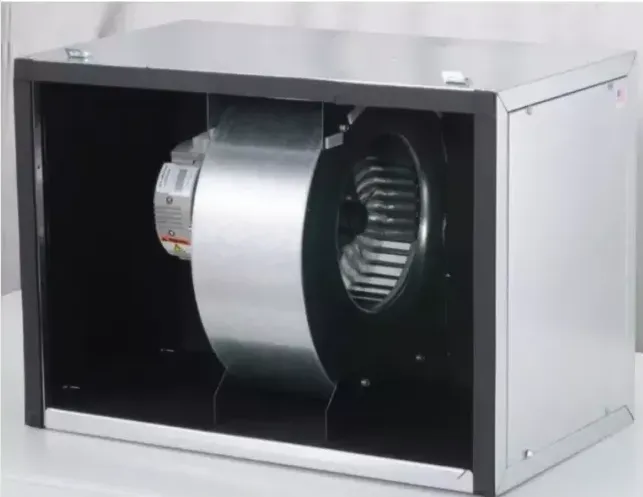
If you’re on a tight budget or replacing an old ducted system, this entry-level option keeps costs low upfront. It’s also a reliable option. With fewer electronic components or AC unit parts, they are less prone to faults.
2. Multi-Speed Air Handlers
A multi-speed air handler gives you more than just on or off. It has two or three speeds to match your home’s cooling needs. It’s like having gears in a car.
On calm autumn afternoons, your system runs slowly, uses less power, and makes less noise. But, when summer gets really hot, it speeds up to keep up.
It costs more than a basic single-speed unit. So, you’re actually paying a little extra for better control.
3. Variable-Speed Air Handlers
You need your blower motor to run from 20% to 100% capacity, adjusting in tiny steps all day? If that’s what you want for your next AC, then a variable speed air handler could be the best choice.
It reads your thermostat and makes small tweaks to keep your temperature just right. That continuous adjustment also gives you the best humidity control you can get with a ducted system.
4. Horizontal Air Handlers
If you go into most Australian roof spaces with ducted air conditioning, you’ll probably see a horizontal air handler sitting flat on the ceiling joists.
These units are perfect for tight, low-clearance spaces. It’s great if you have an older, single-storey home with only about a metre of attic space.
5. Vertical Air Handlers
Why even think about a vertical air handler if a horizontal one works just fine?
Vertical units stand upright, like a tall cabinet, and usually fit in a closet, garage, or utility room. They’re great if you have more vertical space than floor space.

Upflow models pull air in from the bottom and send it out the top, which is perfect if your ducts run up into the ceiling. Downflow models do the reverse which is ideal for attics where the ducts drop into your rooms.
6. Ducted Air Handlers
This is the common setup for most central air conditioning in Australia. Your ducted air handler connects to hidden ductwork in your roof, sending cool or warm air through vents in your ceiling.
What’s great about ducted systems is what you don’t see. No wall units or big indoor units above doors, just small ceiling vents that blend in.
7. Fan Coil Units (Ductless)
Want a simpler option that skips the ductwork and avoids ducted air conditioning repair? You can try a ductless air handler.
It’s also called a fan coil unit because that’s exactly what’s inside, a fan and a coil that condition the air for that single room.
If you’re renovating an older home, a fan coil unit gives you air conditioning without the major renovation.
Components of an Air Handler
These are the most important parts of your air handler unit that you need to know:
1. Housing
There is a metal cover that protects your air handler’s components. Made of galvanised steel, it can handle roof temps up to 50°C. It also keeps out dust, dirt, and bumps when you’re on the roof.
You’ll see hinged doors or removable panels on the front and sides that swing open for filter changes and maintenance. Inside, there’s foam or fibreglass insulation to stop condensation.
2. Blower Motor
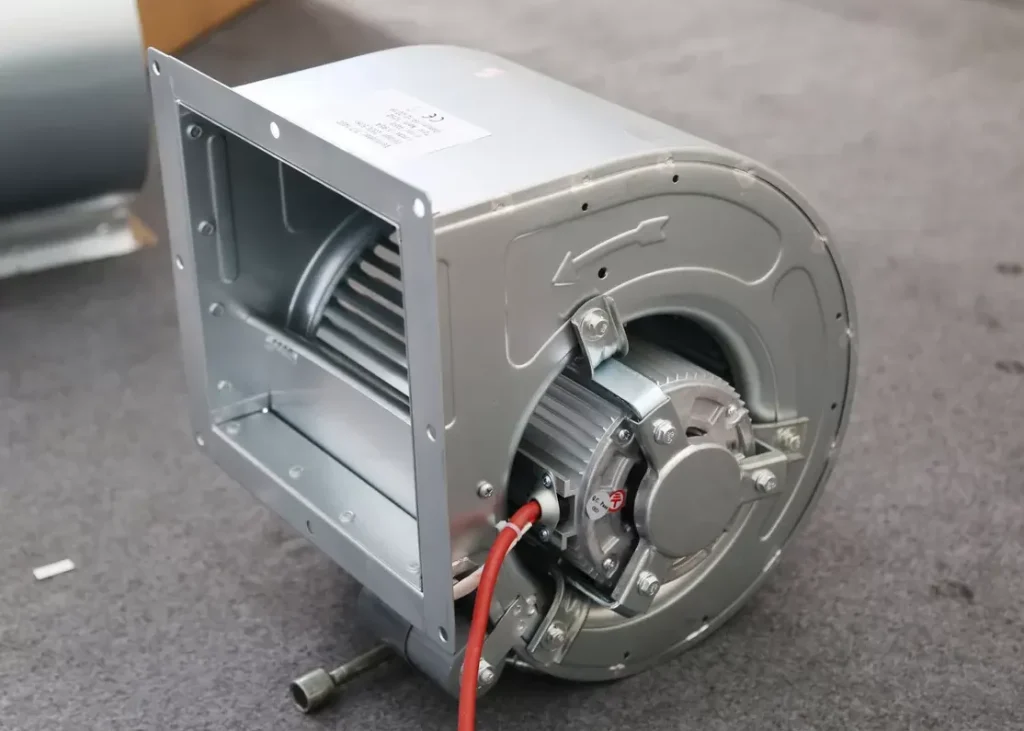
The blower motor is the component that moves air through your system. You’ll hear it running whenever your system’s on. If it stops working, airflow stops too, even if the outdoor unit is still running.
3. Evaporator Coil
This is one of the unique components in your air handler. It’s called an evaporator coil when it cools your home, but if you have a reverse-cycle heat pump, it becomes the condenser coil when heating.
The coil looks like many thin metal fins stacked close together, usually in an A-shape or N-shape inside the unit.
4. Air Filter
The next component of your air handler is the air filter. It’s located in the return air path, either at the air handler itself or in the return grilles around your house.
Its primary job is to protect your equipment by trapping dust, dirt, and debris before they reach the sensitive blower and coil.
5. Drain Pan
Ever wonder where the water from your AC goes? When warm, humid air hits the cold coil, moisture condenses on it, just like water beads on a cold drink on a hot day. That water then drips into the pan right underneath.
Most drain pans are made of plastic or galvanised metal and are shaped to direct water to the drain.
6. Drain Line
This is the component of your air handler that can shut down your entire AC system if it fails.
The drain line carries water that collects in the drain pan outside your house. It’s usually a PVC pipe that goes from the air handler through the roof or wall.
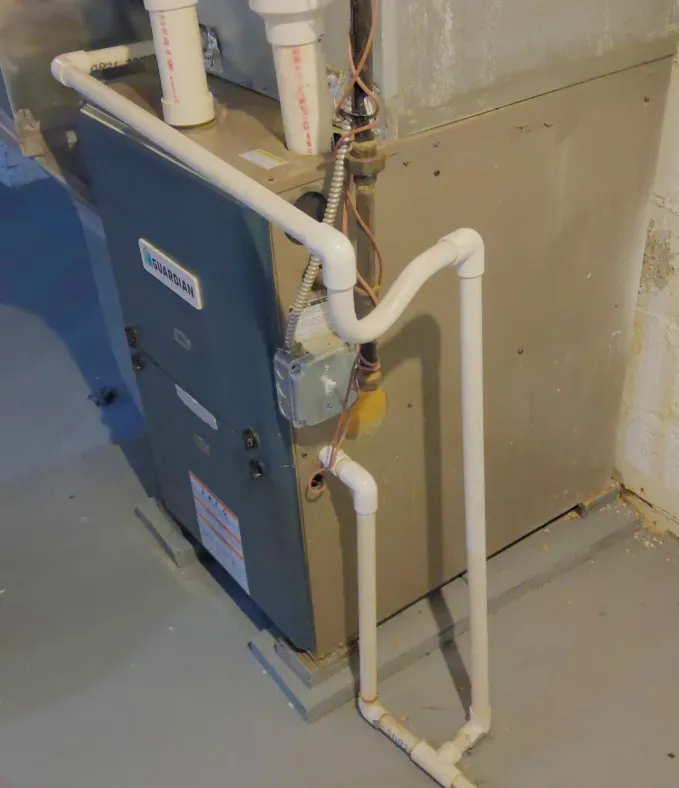
The line has a P-trap to prevent air from escaping back in. When the drain clogs, water backs up into the overflow pan. This triggers a float switch, which turns off the system to prevent leaks onto the ceiling.
7. Plenum
The plenum is a metal box above or below your air handler. It’s the transition spot between the unit and your ducts.
Its main job is to collect air from the blower and spread it evenly to all the supply ducts. Without it, air would rush into the closest duct unevenly.
8. Control Board
This air handler component controls everything, from blower speed to when cooling begins and ends. It listens to signals from your thermostat and sends commands to the blower motor, outdoor unit, and other parts.
If the control board fails, the whole system stops, even if other components are working.
9. Refrigerant Lines
Did you see two copper pipes connecting your indoor air handler to the outdoor condenser? The smaller one is the liquid line, and the bigger one is the vapour or suction line. These are the refrigerant lines.

If either line leaks, refrigerant escapes, and your system won’t cool properly. You’ll need a professional to check the pressure and add more refrigerant if needed.
Do You Need an Air Handler on Your Property?
You’ve learned about your air handlers, right? But now, you might be wondering, “Do I really need one for my place?”
Yes, you need an air handler if:
- You are installing a central air conditioning system that uses ducts
- You don’t have a gas furnace
- You’re using a heat pump system without a furnace
- You already have ductwork in your attic
- Your current air handler is old and not working well
No, you don’t need an air handler if:
- You have a gas furnace with a built-in blower that works as your air handler
- You use split systems or mini-splits, which have fan coil units in each indoor part
- You don’t have ductwork and don’t plan to add any
- You don’t need a central system
How to Maintain an Air Handler Properly
If you have an air handler, keep it running well by doing a few simple things:
- Change or clean your air filter every 2-3 months
- Listen for strange noises like grinding, squealing, or humming
- Look for water dripping from the overflow pan
- Make sure the external drain line outlet isn’t blocked
- Look for visible signs of rust, leaks, or moisture around the housing
- Schedule annual professional air handler servicing to prevent your AC not blowing cold air
- Perform annual comprehensive system tune-up before summer season
FAQ about Air Handler
These are some questions about the air handler unit in an HVAC system:
What is the difference between an AC and an air handler?
Your air conditioner is the outdoor unit that removes heat. Your air handler is the indoor unit that pushes the cooled air through your ducts. In a split-system, they work together.
Does every home have an air handler?
Only homes with ducted central air systems have an air handler. If you use wall-mounted split systems or portable air conditioners, your setup doesn’t include one.
What is another name for an air handler?
An air handler is also called an indoor unit, AHU, or blower unit. While the technical term “fan coil unit” can refer to it, that name is usually for the indoor part of a ductless split system.
Where is the air handler located in a house?
You’ll usually find your air handler in the roof space or attic. It can also be installed in a garage, basement, or a dedicated utility cupboard, depending on your home’s layout and ductwork.
What is the life expectancy of an AC air handler?
With regular maintenance, your air handler will last 15-20 years. But skip annual services and filter changes, and its life can drop to just 10 years.
Conclusion
Now you know what that metal box in your attic is for. It’s an air handler, and it moves air through the ducts to cool or heat your home.
You’ve learned about the parts inside, whether you need one or which types of air handlers to choose from. Also, you know which maintenance tasks you can do yourself and which ones need a professional.
But when it’s time for installation, replacement, or yearly service, contact a qualified professional. At Lightning Bult , we’re ready to answer your questions, assess your system, and recommend the best air handler for your home.



